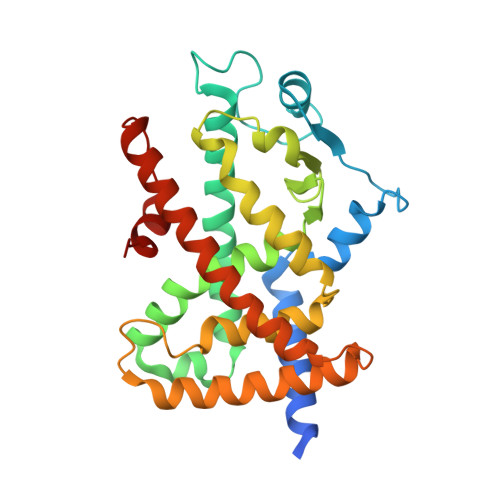Crystal Structure of the Peroxisome Proliferator-Activated Receptor gamma (PPARgamma) Ligand Binding Domain Complexed with a Novel Partial Agonist: A New Region of the Hydrophobic Pocket Could Be Exploited for Drug Design
Montanari, R., Saccoccia, F., Scotti, E., Crestani, M., Godio, C., Gilardi, F., Loiodice, F., Fracchiolla, G., Laghezza, A., Tortorella, P., Lavecchia, A., Novellino, E., Mazza, F., Aschi, M., Pochetti, G.(2008) J Med Chem 51: 7768-7776
- PubMed: 19053776
- DOI: https://doi.org/10.1021/jm800733h
- Primary Citation of Related Structures:
3B3K, 3CDS, 3D6D - PubMed Abstract:
The peroxisome proliferator-activated receptors (PPARs) are ligand-dependent transcription factors regulating glucose and lipid metabolism. The search for new PPAR ligands with reduced adverse effects with respect to the marketed antidiabetic agents thiazolidinediones (TZDs) and the dual-agonists glitazars is highly desired. We report the crystal structure and activity of the two enantiomeric forms of a clofibric acid analogue, respectively complexed with the ligand-binding domain (LBD) of PPARgamma, and provide an explanation on a molecular basis for their different potency and efficacy against PPARgamma. The more potent S-enantiomer is a dual PPARalpha/PPARgamma agonist which presents a partial agonism profile against PPARgamma. Docking of the S-enantiomer in the PPARalpha-LBD has been performed to explain its different subtype pharmacological profile. The hypothesis that partial agonists show differential stabilization of helix 3, when compared to full agonists, is also discussed. Moreover, the structure of the complex with the S-enantiomer reveals a new region of the PPARgamma-LBD never sampled before by other ligands.
Organizational Affiliation:
Consiglio Nazionale delle Ricerche, Roma 00016, Italy.















